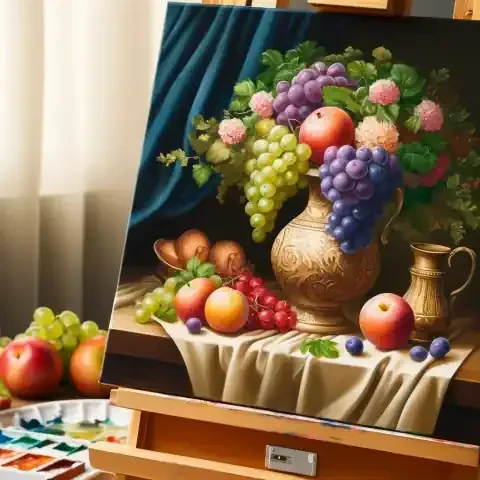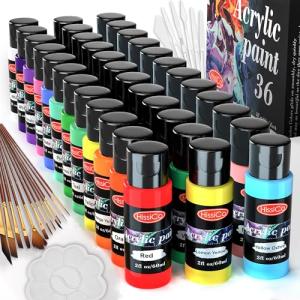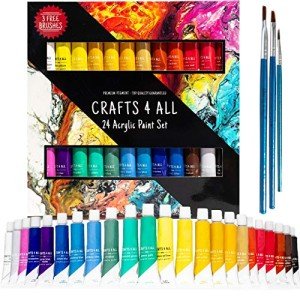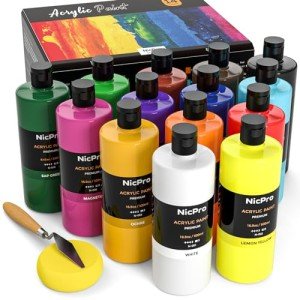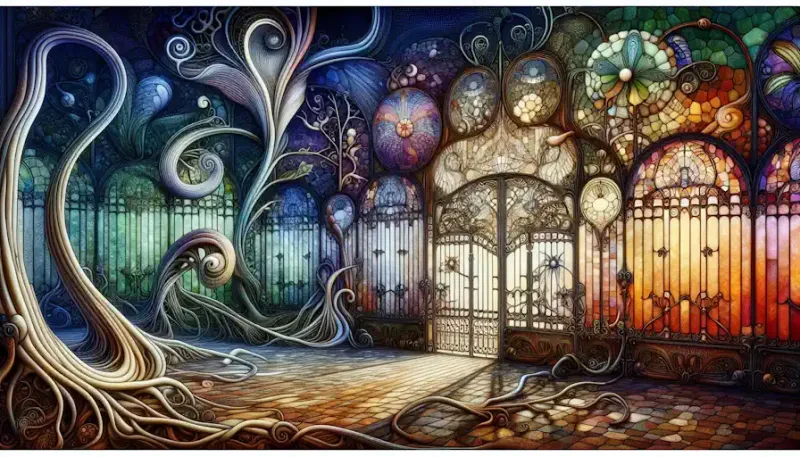Introduction to Acrylic Painting
Acrylic painting stands as a vibrant and accessible medium, offering a plethora of creative possibilities for artists at every level. It's a medium that has gained popularity for its versatility, fast-drying properties, and ease of use, making it particularly attractive to beginners eager to dive into the world of visual art.
Explanation of Acrylic Paints
Acrylic paints are composed of pigments suspended in an acrylic polymer emulsion. This unique formulation gives acrylics their quick-drying nature, allowing artists to work rapidly and efficiently. Unlike oil paints, which require lengthy drying times, acrylics dry relatively quickly, enabling artists to layer colors, blend seamlessly, and make corrections swiftly. This rapid drying time makes acrylic painting an ideal choice for those seeking immediate results and the ability to work on multiple layers without extensive waiting periods.
One of the defining characteristics of acrylic paints is their ability to be diluted with water. This feature grants artists greater control over the consistency of their paint, ranging from thick impasto applications to delicate washes. Additionally, acrylic paints can be used on a variety of surfaces, including canvas, paper, wood, and even fabric, expanding the possibilities for artistic expression.
Why Acrylic Painting is Suitable for Beginners
Acrylic painting offers several advantages that make it particularly well-suited for beginners embarking on their artistic journey. Firstly, acrylic paints are readily available and come in a wide range of colors, including hues that mimic the appearance of oil and watercolor paints. This accessibility allows beginners to experiment with different color palettes and techniques without the need for extensive investment.
Furthermore, the forgiving nature of acrylic paints makes them forgiving for beginners who may still be honing their skills. Unlike some other mediums, acrylics can be easily corrected or painted over if mistakes are made, allowing artists to explore and learn without fear of ruining their work irreparably.
Additionally, acrylic painting techniques can be learned relatively quickly, providing beginners with a sense of accomplishment and progress early on in their artistic endeavors. With practice and exploration, beginners can develop their skills and create captivating artworks in a relatively short amount of time.
Overall, acrylic painting offers beginners a welcoming entry point into the world of visual art, providing them with the tools, flexibility, and encouragement needed to unleash their creativity and express themselves through painting.
Essential Materials and Tools
Acquiring the necessary materials and tools is the first step towards embarking on your acrylic painting journey. Understanding the different options available and how they contribute to your artistic process is essential for creating successful and satisfying artworks.
Types of Acrylic Paints
When it comes to acrylic paints, there is a wide array of options to choose from, each offering unique characteristics and qualities. Understanding the differences between them can help you select the best paints for your needs.
Artist-Quality Acrylics: These paints contain a higher concentration of pigments and offer superior lightfastness and color vibrancy compared to student-grade acrylics. They are ideal for artists seeking professional results and longevity in their artwork.
Student-Grade Acrylics: Student-grade acrylic paints are more affordable and contain fewer pigments than artist-quality acrylics. While they may lack some of the vibrancy and lightfastness of their higher-grade counterparts, they are suitable for beginners and those experimenting with acrylic painting for the first time.
Heavy Body vs. Soft Body Acrylics: Acrylic paints come in various consistencies, ranging from thick, buttery textures (heavy body) to fluid, pourable formulations (soft body). Heavy body acrylics are excellent for impasto techniques and retaining brushstrokes, while soft body acrylics are ideal for glazing, pouring, and detailed work.
Acrylic Inks and Spray Paints: In addition to traditional acrylic paints, there are acrylic inks and spray paints available, offering alternative ways to apply color to your artwork. Acrylic inks are highly pigmented and can be used for fine detail work and staining techniques, while acrylic spray paints are convenient for creating large-scale artworks and applying color quickly and evenly.
Brushes and Palette Knives
Choosing the right brushes and palette knives is crucial for achieving various effects and textures in your acrylic paintings. Here are some essential tools to consider:
Brushes: Acrylic paintbrushes come in a variety of shapes, sizes, and materials, each suited to different painting techniques and styles. Flat brushes are ideal for covering large areas and creating bold strokes, while round brushes are versatile and suitable for detailed work and fine lines. Additionally, filbert brushes have a rounded tip that can be used for blending and softening edges, while fan brushes are excellent for creating texture and foliage effects.
Palette Knives: Palette knives are essential tools for applying and manipulating acrylic paint on the canvas. They come in various shapes and sizes, with flexible blades that allow artists to achieve a range of textures and effects. Palette knives can be used to apply paint thickly (impasto technique), scrape away paint to reveal underlying layers, and create intricate details and textures.
Surfaces for Painting
Selecting the right surface for your acrylic painting is crucial for achieving the desired results and longevity of your artwork. Here are some common surfaces used for acrylic painting:
Canvas: Stretched canvas is a popular choice for acrylic painting due to its durability and stability. Canvas boards and canvas panels are also available, offering a more affordable alternative for beginners.
Wood Panels: Wooden panels provide a sturdy and smooth surface for acrylic painting, allowing for a variety of techniques and finishes. They can be primed with gesso to create a suitable painting surface.
Acrylic Paper and Boards: Acrylic paper and boards are specially designed for use with acrylic paints, offering a smooth surface that resists buckling and warping. They are available in various weights and textures to suit different preferences.
Other Surfaces: Acrylic paints can be applied to a wide range of surfaces, including paper, cardboard, metal, and fabric. Experimenting with different surfaces can yield unique results and expand your artistic possibilities.
By investing in high-quality materials and tools suited to your preferences and artistic goals, you can set yourself up for success and enjoy a rewarding acrylic painting experience. Experimenting with different paints, brushes, and surfaces will allow you to discover new techniques and develop your unique artistic style.
Setting Up Your Workspace
Creating a conducive and organized workspace is essential for maximizing your enjoyment and productivity as you delve into acrylic painting. From selecting the right environment to arranging your materials for easy access, setting up your workspace thoughtfully can significantly impact your painting experience.
Choosing a Suitable Area
Selecting the right location for your painting space is the first step in setting up your acrylic painting workspace. Consider the following factors when choosing a suitable area:
Natural Light: Whenever possible, choose a space with ample natural light. Natural light provides the most accurate color representation and helps reduce eye strain during extended painting sessions. Position your easel or painting surface near a window to take advantage of natural light while painting.
Ventilation: Acrylic paints emit fumes and odors, especially when used in large quantities or in poorly ventilated areas. Ensure that your painting space is well-ventilated to minimize exposure to potentially harmful fumes. Open windows or use a fan to improve airflow in your workspace.
Comfort: Your painting space should be comfortable and conducive to creativity. Choose a space with adequate seating and ergonomic support to prevent fatigue and discomfort during long painting sessions. Consider investing in a comfortable chair or stool with adjustable height to suit your preferences.
Protection: Acrylic paints can be messy, and accidental spills or splatters are common during painting sessions. Protect your workspace by covering surfaces with plastic drop cloths or newspapers to prevent damage from paint spills. Consider using a dedicated apron or old clothing to protect your clothes from paint splatters.
Organizing Materials for Easy Access
Once you've chosen a suitable area for your painting space, it's time to organize your materials for easy access and efficiency. Here are some tips for organizing your acrylic painting materials:
Storage Solutions: Invest in storage containers, shelves, or drawers to keep your acrylic paints, brushes, and other supplies organized and easily accessible. Use labeled containers to categorize and store paints by color or brand for quick identification.
Workspace Layout: Arrange your painting materials in a way that minimizes clutter and maximizes efficiency. Keep frequently used supplies within arm's reach of your painting area to streamline your workflow. Consider installing a pegboard or wall-mounted organizer to keep brushes, palette knives, and other tools within easy reach.
Cleaning Station: Set up a designated area for cleaning and maintaining your painting tools. Keep water containers, paper towels, and cleaning supplies nearby for quick and convenient cleanup between painting sessions. Properly cleaning your brushes and tools after each use helps prolong their lifespan and ensures optimal performance.
Inspiration Corner: Create an inspiration corner in your workspace to display reference materials, sketches, and inspirational artwork. Surrounding yourself with visual stimuli can help spark creativity and keep you motivated throughout your painting journey.
By carefully selecting a suitable area for your painting space and organizing your materials for easy access and efficiency, you can create an inviting and productive workspace that enhances your acrylic painting experience. A well-organized workspace fosters creativity, minimizes distractions, and allows you to focus fully on the process of creating art.
Understanding Acrylic Paints
Before diving into your first acrylic painting project, it's essential to have a solid understanding of acrylic paints, including their properties, characteristics, and various applications. This knowledge will empower you to make informed decisions when selecting paints, mediums, and techniques for your artwork.
Properties of Acrylic Paints
Acrylic paints consist of pigments suspended in an acrylic polymer emulsion, which gives them several unique properties that set them apart from other painting mediums:
Fast Drying: One of the most notable characteristics of acrylic paints is their fast-drying nature. Unlike oil paints, which can take days or even weeks to dry completely, acrylic paints dry rapidly, often within minutes to hours depending on factors such as thickness of application, humidity, and airflow. This quick drying time allows artists to work efficiently and apply multiple layers of paint in a single painting session.
Versatility: Acrylic paints are incredibly versatile and can be applied to a wide range of surfaces, including canvas, paper, wood, fabric, and more. They can be used alone or combined with various mediums to achieve different effects, from thick impasto textures to smooth, translucent glazes.
Opacity and Transparency: Acrylic paints come in a range of opacities, from opaque to transparent. This allows artists to create dynamic compositions by layering colors and adjusting the transparency of each layer. Opaque acrylics provide excellent coverage and can be used to block out underlying colors, while transparent acrylics allow for subtle color blending and glazing effects.
Permanent and Lightfast: When applied correctly and cared for properly, acrylic paints are highly permanent and resistant to fading over time. Look for acrylic paints labeled as "lightfast" to ensure the longevity of your artwork, especially if it will be displayed in direct sunlight or high-UV environments.
Different Acrylic Mediums and Their Uses
In addition to traditional acrylic paints, there is a wide range of mediums available that can be mixed with acrylics to achieve various effects and finishes. Understanding the different acrylic mediums and their uses will expand your creative possibilities and allow you to experiment with new techniques:
Gloss, Matte, and Satin Mediums: Acrylic mediums come in different finishes, including gloss, matte, and satin. These mediums can be mixed with acrylic paints to alter the sheen and surface texture of the finished artwork. Gloss mediums enhance color vibrancy and create a glossy, reflective surface, while matte mediums produce a flat, non-reflective finish. Satin mediums offer a compromise between gloss and matte, providing a subtle sheen without being too shiny.
Texture Mediums: Texture mediums, such as modeling paste and gel medium, are used to add dimension and texture to acrylic paintings. These mediums can be applied with palette knives or brushes to create raised impasto textures, collage effects, or intricate details. Experimenting with different texture mediums allows artists to explore surface manipulation and create tactile, three-dimensional artworks.
Retarders and Extenders: Retarders and extenders are additives that can be mixed with acrylic paints to slow down the drying time and increase workability. Retarders are particularly useful for artists who prefer to work wet-on-wet or blend colors seamlessly on the canvas. Extenders, on the other hand, increase the transparency and flow of acrylic paints, allowing for smoother brushstrokes and extended blending time.
By familiarizing yourself with the properties of acrylic paints and experimenting with different mediums and additives, you can unlock a world of creative possibilities and take your acrylic painting skills to new heights. Whether you're a beginner or an experienced artist, understanding acrylic paints is the foundation for creating vibrant, expressive artworks that captivate and inspire.
Basic Techniques in Acrylic Painting
Mastering basic acrylic painting techniques is essential for creating visually compelling artworks and expressing your artistic vision effectively. Whether you're a beginner or an experienced artist, understanding and practicing these fundamental techniques will lay the groundwork for your acrylic painting journey.
Color Mixing Fundamentals
Color Theory: Familiarize yourself with the basics of color theory, including primary, secondary, and tertiary colors, as well as complementary, analogous, and triadic color schemes. Understanding how colors interact with each other will help you create harmonious compositions and achieve the desired visual impact in your paintings.
Color Mixing: Experiment with mixing different colors using a limited palette of primary colors (red, blue, yellow) plus white. Practice mixing various shades, tints, and tones by adjusting the proportions of each color. Use a palette knife or brush to blend colors smoothly and achieve subtle transitions between hues.
Creating Depth and Dimension: Learn how to use color to create the illusion of depth and dimension in your paintings. Use warm colors to advance objects and cool colors to recede them. Experiment with atmospheric perspective by making distant objects lighter, cooler, and less saturated than closer objects.
Brush Techniques
Brush Selection: Choose the right brushes for the task at hand based on their shape, size, and bristle type. Flat brushes are ideal for covering large areas and creating sharp edges, while round brushes are versatile and suitable for both detail work and broad strokes. Experiment with different brush shapes and sizes to achieve various textures and effects.
Loading and Application: Load your brush with paint by dipping it into the desired color and dragging it along the palette to evenly distribute the paint. Practice controlling the amount of paint on your brush to achieve different levels of opacity and coverage. Experiment with different brush pressures and strokes to create varied textures and marks on the canvas.
Blending and Layering: Explore techniques for blending and layering colors to create smooth transitions and subtle gradations. Use a dry brush or a damp brush to blend colors together seamlessly on the canvas. Experiment with layering translucent glazes to build up depth and complexity in your paintings.
Applying Acrylic Mediums for Effects
Impasto Technique: Experiment with applying thick layers of paint (impasto) using a palette knife or stiff brush. Build up texture and dimension on the canvas by layering thick strokes of paint and sculpting the surface with the edge of the palette knife. Use impasto to create dynamic, expressive effects and add tactile interest to your paintings.
Glazing Technique: Explore the glazing technique by thinning acrylic paints with water or acrylic medium and applying them in translucent layers over dry base layers. Experiment with layering multiple glazes to create rich, luminous colors and subtle color shifts. Use glazing to enhance depth, add atmosphere, and create mood in your paintings.
Drybrush Technique: Practice the drybrush technique by loading a small amount of paint onto a dry brush and lightly dragging it over the textured surface of the canvas. This technique creates broken, stippled marks and adds visual interest to areas of your painting. Experiment with varying pressure and brush angles to achieve different effects.
By mastering these basic acrylic painting techniques, you'll gain confidence in your abilities and develop a solid foundation for exploring more advanced concepts and styles. Remember to practice regularly, experiment with different techniques, and embrace the creative process as you continue your acrylic painting journey. With dedication and persistence, you'll unlock your full artistic potential and create stunning artworks that resonate with viewers.
Step-by-Step Painting Projects
Embarking on step-by-step painting projects is an excellent way for beginners to apply their newfound knowledge of acrylic painting techniques in a structured and guided manner. These projects provide a framework for learning and experimentation while allowing artists to create beautiful artworks from start to finish. Below are three step-by-step painting projects that cover different subjects and techniques, perfect for beginners looking to hone their skills and unleash their creativity.
Simple Landscape Painting
Step 1: Sketching the Composition
Begin by sketching the basic outlines of your landscape composition onto a primed canvas using a pencil or charcoal. Consider elements such as the horizon line, foreground, middle ground, and background, as well as any focal points or points of interest.
Step 2: Blocking in Colors and Shapes
Using a large flat brush, block in the basic colors and shapes of your landscape using diluted acrylic paint. Start with the sky and background elements, gradually working your way forward to the middle ground and foreground. Keep your brushstrokes loose and gestural, focusing on capturing the overall mood and atmosphere of the scene.
Step 3: Adding Details and Highlights
Once the initial layers have dried, begin adding details and highlights to your landscape using smaller brushes and thicker paint. Pay attention to areas of contrast and focal points, such as sunlight hitting the tops of trees or reflections in water. Use a combination of opaque and translucent paint to create depth and texture in your painting.
Still Life Painting
Step 1: Setting Up a Still Life Arrangement
Gather a selection of objects to use as subjects for your still life painting, such as fruits, flowers, and household items. Arrange the objects on a table or pedestal, taking into account factors such as composition, lighting, and perspective. Experiment with different arrangements until you find one that appeals to you.
Step 2: Understanding Light and Shadow
Observe how light falls on your still life arrangement and identify areas of light and shadow. Pay attention to the direction of light, as well as the intensity and quality of shadows cast by each object. Use a combination of warm and cool colors to capture the subtle variations in light and shadow.
Step 3: Painting Different Textures
Begin blocking in the basic shapes and colors of your still life objects using acrylic paint. Pay close attention to the different textures and surfaces of each object, such as the smooth skin of a fruit or the rough texture of a tabletop. Use a variety of brushstrokes and techniques to convey the unique characteristics of each object.
Abstract Acrylic Painting
Step 1: Exploring Shapes and Forms
Start by creating a series of abstract shapes and forms on a primed canvas using acrylic paint. Experiment with different brushstrokes, mark-making techniques, and layering effects to build up interesting textures and patterns. Allow yourself to work intuitively and spontaneously, focusing on the process rather than the end result.
Step 2: Experimenting with Color Blending and Layering
Explore the interaction of colors by blending and layering different hues on your canvas. Use a limited palette of colors to maintain harmony and cohesion in your abstract composition. Experiment with complementary and analogous color schemes, as well as contrasting warm and cool tones, to create visual interest and depth.
Step 3: Adding Personal Touches and Meaning
As your abstract painting evolves, consider adding personal touches and meaningful elements to imbue your artwork with significance. Incorporate symbols, shapes, or gestural marks that reflect your emotions, experiences, or aspirations. Trust your intuition and allow your painting to evolve organically, embracing the spontaneous and unpredictable nature of abstract art.
By following these step-by-step painting projects and embracing the creative process, beginners can develop their acrylic painting skills and create beautiful artworks that reflect their unique style and vision. Remember to approach each project with an open mind and a willingness to experiment, and most importantly, have fun exploring the endless possibilities of acrylic painting!
Troubleshooting Common Issues
While acrylic painting is a rewarding and versatile medium, beginners may encounter certain challenges or issues along the way. Understanding how to troubleshoot these common problems can help you overcome obstacles and achieve the desired results in your artwork. Below are some common issues that beginners may face when working with acrylic paints, along with tips for troubleshooting and resolving them effectively.
Dealing with Paint Drying Too Quickly or Too Slowly
Quick Drying: If your acrylic paint is drying too quickly on the palette or canvas, try using a palette with a lid or a spray bottle filled with water to keep the paint moist. You can also mix a small amount of acrylic retarder or slow-drying medium into your paint to extend its working time.
Slow Drying: Conversely, if your acrylic paint is drying too slowly, ensure that you're working in a well-ventilated area with adequate airflow. Avoid applying thick layers of paint, as this can prolong drying time. You can also use a hairdryer on a low setting to speed up the drying process between layers.
Fixing Mistakes and Making Corrections
Immediate Corrections: Acrylic paints dry quickly, which means you can make immediate corrections to your artwork if needed. Use a damp brush or paper towel to lift off wet paint from the canvas or scrape away excess paint with a palette knife. Alternatively, you can paint over mistakes with fresh layers of paint once the previous layers have dried.
Sandpaper or Sanding Block: For more stubborn mistakes or dried paint, gently sand the surface of the canvas with fine-grit sandpaper or a sanding block to remove unwanted texture or paint buildup. Be careful not to sand too aggressively, as this can damage the canvas or underlying layers of paint.
Preventing Cracking or Flaking of Acrylic Paint
Proper Surface Preparation: Ensure that your painting surface is properly prepared before applying acrylic paint. Prime your canvas with acrylic gesso or apply a suitable primer to other surfaces to create a stable and absorbent surface for paint adhesion.
Avoiding Excessive Thinning: Avoid thinning acrylic paint with too much water or acrylic medium, as this can weaken the paint film and lead to cracking or flaking over time. Use a balanced ratio of paint to medium to maintain the integrity and durability of your artwork.
Flexible Support: If working on a flexible surface such as canvas, consider using a stretcher frame or bracing system to prevent warping or distortion over time. Alternatively, you can mount your finished painting onto a rigid support such as a wooden panel for added stability.
By familiarizing yourself with these common issues and troubleshooting techniques, you can navigate potential challenges with confidence and continue to grow and improve as an acrylic painter. Remember that experimentation and practice are key to mastering any artistic medium, so don't be discouraged by setbacks and keep pushing yourself to explore new techniques and push the boundaries of your creativity.
Tips for Progression and Further Learning
Continuing to progress and improve as an acrylic painter involves a combination of regular practice, exploration, and ongoing learning. Whether you're a beginner just starting out or an experienced artist looking to refine your skills, incorporating these tips into your painting practice can help you reach new heights in your artistic journey.
Practice Regularly to Improve Skills
Set Aside Dedicated Painting Time: Establish a regular painting schedule and commit to spending time at your easel each week. Consistency is key to improving your skills and developing your artistic style.
Experiment with Different Techniques: Don't be afraid to step out of your comfort zone and try new techniques and approaches to painting. Experiment with different brushstrokes, textures, and styles to discover what resonates with you as an artist.
Keep a Sketchbook: Carry a sketchbook with you wherever you go and use it to sketch ideas, observations, and inspiration. Sketching regularly helps improve your drawing skills and provides a valuable resource for developing ideas for future paintings.
Explore Different Subject Matter and Styles
Expand Your Subject Matter: Challenge yourself to paint a variety of subjects, from landscapes and still lifes to portraits and abstract compositions. Exploring different subject matter will broaden your artistic horizons and help you develop a diverse portfolio of work.
Study Art History: Take the time to study the work of master artists from different periods and movements in art history. Analyze their techniques, compositions, and use of color, and consider how you can incorporate elements of their style into your own work.
Develop Your Unique Style: While it's important to learn from other artists, don't forget to cultivate your own unique artistic voice. Experiment with different approaches to painting and allow your personality and experiences to shine through in your artwork.
Seek Inspiration from Other Artists and Resources
Visit Galleries and Museums: Take advantage of opportunities to view art in person by visiting galleries, museums, and exhibitions in your area. Seeing artwork up close can provide valuable insights into technique, composition, and artistic expression.
Engage with Online Communities: Join online forums, social media groups, and artist communities to connect with fellow painters and share ideas, tips, and inspiration. Participating in online challenges and collaborations can also provide motivation and accountability for your painting practice.
Invest in Art Books and Courses: Expand your knowledge and skills by investing in art books, instructional DVDs, and online courses focused on acrylic painting techniques and theory. Learning from experienced artists and instructors can provide valuable guidance and mentorship as you progress in your artistic journey.
By incorporating these tips into your painting practice and approach to learning, you'll continue to grow and evolve as an acrylic painter. Remember to stay curious, open-minded, and persistent in your pursuit of artistic excellence, and never hesitate to seek out new opportunities for growth and inspiration along the way.
Resources for Further Learning
Expanding your knowledge and honing your skills as an acrylic painter involves seeking out valuable resources and educational opportunities that can provide guidance, inspiration, and support. Whether you prefer books, online tutorials, or hands-on instruction, there are numerous resources available to help you continue your journey as an acrylic painter. Below are some recommended resources for further learning and exploration in the world of acrylic painting:
Online Tutorials and Courses
YouTube Channels: Explore YouTube channels dedicated to acrylic painting tutorials, demonstrations, and tips from experienced artists. Channels such as "Painting with Jane," "Art by Roossin," and "Lena Danya" offer a wealth of instructional videos covering various techniques, subjects, and styles.
Online Courses: Enroll in online courses offered by reputable art schools, instructors, and platforms specializing in acrylic painting. Websites like Skillshare, Udemy, and Coursera offer a wide range of courses taught by professional artists, covering everything from beginner basics to advanced techniques and specialized topics.
Books on Acrylic Painting
Instructional Books: Invest in instructional books written by acclaimed acrylic painters that cover fundamental techniques, advanced concepts, and practical advice for artists of all skill levels. Look for titles such as "Acrylic Painting Techniques: Learn to Paint with Acrylics" by DK Publishing, "Acrylics for the Absolute Beginner" by Charles Evans, and "Acrylic Solutions: Exploring Mixed Media Layer by Layer" by Chris Cozen.
Artistic Inspiration: Explore books featuring the work of influential acrylic painters and gain insights into their creative processes, inspirations, and artistic philosophies. Books like "AcrylicWorks: The Best of Acrylic Painting" series by North Light Books showcase stunning acrylic artworks and offer commentary from the artists themselves.
Local Art Classes or Workshops
Community Centers and Art Schools: Check local community centers, art schools, and studios for acrylic painting classes and workshops offered by experienced instructors. Participating in in-person classes provides hands-on instruction, personalized feedback, and the opportunity to connect with other artists in your community.
Artist Retreats and Workshops: Consider attending artist retreats or workshops led by renowned acrylic painters in inspiring locations around the world. These immersive experiences offer the chance to learn new techniques, gain insights from professional artists, and immerse yourself in a supportive and creative environment.
Online Communities and Forums
Social Media Groups: Join online communities and social media groups dedicated to acrylic painting, where you can connect with fellow artists, share your work, ask questions, and receive feedback and encouragement. Platforms like Facebook, Instagram, and Reddit host vibrant communities of acrylic painters of all skill levels.
Artist Forums and Websites: Explore online forums, websites, and discussion boards focused on acrylic painting, where you can engage in conversations, exchange ideas, and learn from other artists. Websites like WetCanvas and The Artist's Road host forums dedicated to acrylic painting, offering valuable resources and support for artists.
By taking advantage of these resources for further learning and exploration, you'll continue to grow and evolve as an acrylic painter, expanding your skills, knowledge, and artistic vision. Remember to approach your learning journey with curiosity, dedication, and an open mind, and don't hesitate to seek out new opportunities for inspiration, education, and connection within the vibrant acrylic painting community.
Conclusion: Embracing the Journey of Acrylic Painting
As you embark on your journey into the world of acrylic painting, remember that it's not just about creating beautiful artworks—it's about embracing the process, cultivating your creativity, and expressing yourself through the vibrant colors and dynamic textures of acrylic paint. Along the way, you'll encounter challenges, make discoveries, and experience moments of inspiration that will shape your growth as an artist. Here are some final thoughts to keep in mind as you continue your exploration of acrylic painting:
Embrace Mistakes and Challenges
Don't be discouraged by mistakes or setbacks—view them as opportunities for growth and learning. Every brushstroke, every experiment, and every painting session is an opportunity to improve and refine your skills as an acrylic painter. Embrace the process of trial and error, and don't be afraid to push the boundaries of your comfort zone.
Stay Curious and Open-Minded
Approach acrylic painting with a sense of curiosity and wonder, and remain open-minded to new techniques, styles, and approaches. Explore different subject matter, experiment with various tools and materials, and allow yourself the freedom to play and explore without judgment. Remember that creativity thrives in an environment of curiosity and experimentation.
Find Joy in the Process
Above all, remember to find joy in the process of acrylic painting. Whether you're mixing colors on your palette, applying paint to the canvas, or simply contemplating your next brushstroke, cherish each moment spent creating art. Allow yourself to be fully present in the act of painting, and savor the sense of satisfaction and fulfillment that comes from bringing your creative vision to life.
As you continue your journey into acrylic painting, remember that there is no right or wrong way to create art—only your unique voice and perspective as an artist. Trust in your instincts, follow your passions, and let your creativity guide you as you explore the boundless possibilities of acrylic painting. Whether you're painting for relaxation, self-expression, or the sheer joy of creation, know that your artistic journey is a deeply personal and meaningful one. Embrace the process, celebrate your progress, and above all, enjoy the transformative power of acrylic painting to enrich your life and nourish your soul.
